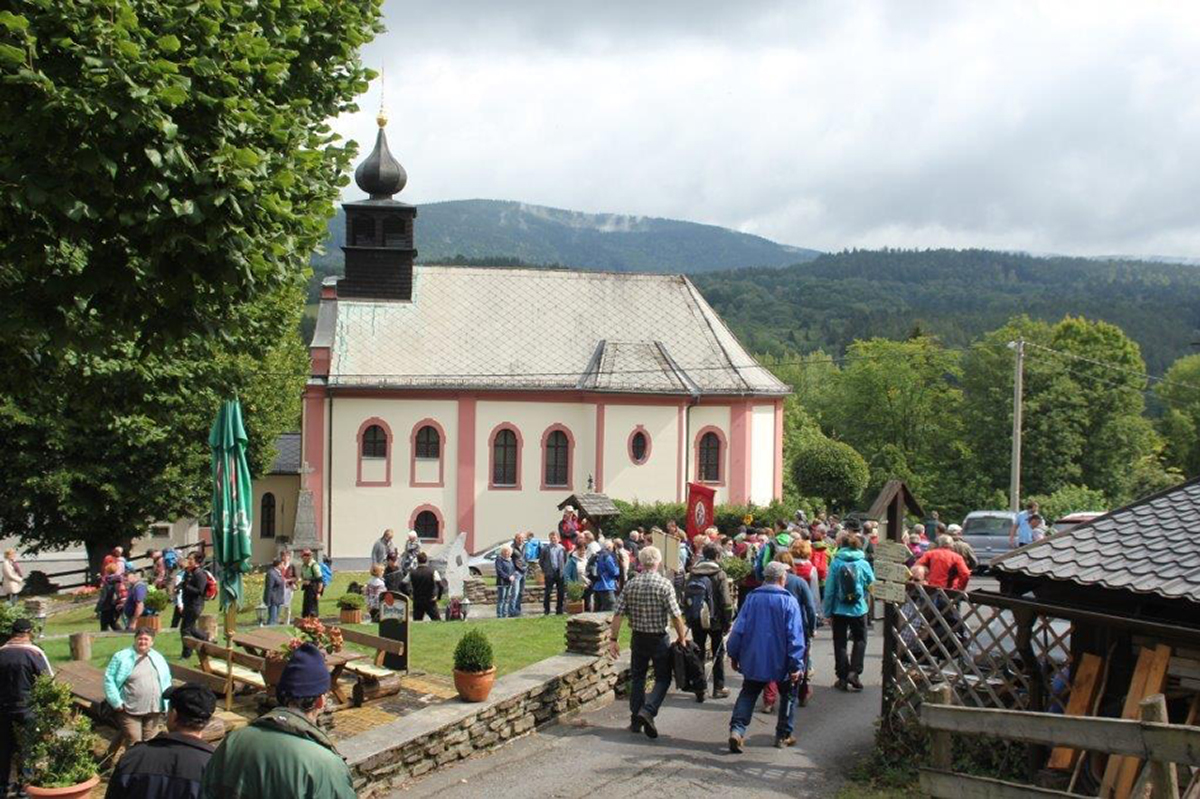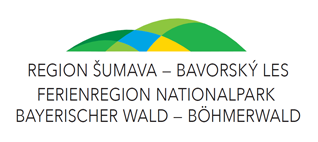2 – Church of Our Lady of Sorrows (Koller’s church)
The dominant feature of Hamry is the Church of Our Lady of Sorrows, which was created during the reconstruction of the original chapel in 1773–74. It was consecrated on October 11, 1774. It was also called after the then benefactor, farmer Koller, on whose property it stood. An old postcard describes Hamry as a pilgrimage site – that is because of the Church of Our Lady of Sorrows.
A school used to be adjacent to the church. It has one nave, of rectangular ground plan, with a Mountain of Olives chapel and a sacristy on the north side. During the socialist regime, the church was robbed several times and the benches were burned. It was not torn down only because of a regime change in 1989. In the beginning of the 1990s, donations from the former German settlers and their families allowed for reconstruction. It was decorated by the traditional reverse glass painting technique, depicting Bohemian saints. The second consecration was carried out on 11.9.1993. by the České Budějovice bishop Mons. Dr. Anotnín Liška. The first mass carried out a day later by the Pilsen bishop Mons. Ing. František Radkovský. In 1996, the church was declared a cultural heritage site.
A new art piece, the Road of Our Lady of Sorrows can be found alongside the footpath with 85 steps leading to the church in Hamry. Ceramic reliefs depicting the seven sorrows of Virgin Mary have been set into the eight granite pillars from the original Stations of the Cross. The eight relief depicts the story of Cana of Galilee, where Jesus turned water into wine. Four more reliefs are inside the church. They were all made by the Klatovy ceramics artist Gustav Fifka. The local committee decided on 11.2.1969 to abolish the cemetery in Hamry, effective from 1.3.1969. Around that time, the local morgue was closed. The tombstones were moved in front of the former school building and used to strengthen an area in front of a house. After 1990, the cemetery was reverentially modified. There is a symbolic headstone which reads: “In memory of those German families, who lived here for centuries, whose members rest on this graveyard, and who were forcibly displaced in 1946”. There is also a new memorial dedicated to the free farmers who used to guard the border, with their motto engraved into granite “Niemands Herr, niemands Knecht” (Nobody’s master, nobody’s servant).
A school used to be adjacent to the church. It has one nave, of rectangular ground plan, with a Mountain of Olives chapel and a sacristy on the north side. During the socialist regime, the church was robbed several times and the benches were burned. It was not torn down only because of a regime change in 1989. In the beginning of the 1990s, donations from the former German settlers and their families allowed for reconstruction. It was decorated by the traditional reverse glass painting technique, depicting Bohemian saints. The second consecration was carried out on 11.9.1993. by the České Budějovice bishop Mons. Dr. Anotnín Liška. The first mass carried out a day later by the Pilsen bishop Mons. Ing. František Radkovský. In 1996, the church was declared a cultural heritage site.
A new art piece, the Road of Our Lady of Sorrows can be found alongside the footpath with 85 steps leading to the church in Hamry. Ceramic reliefs depicting the seven sorrows of Virgin Mary have been set into the eight granite pillars from the original Stations of the Cross. The eight relief depicts the story of Cana of Galilee, where Jesus turned water into wine. Four more reliefs are inside the church. They were all made by the Klatovy ceramics artist Gustav Fifka. The local committee decided on 11.2.1969 to abolish the cemetery in Hamry, effective from 1.3.1969. Around that time, the local morgue was closed. The tombstones were moved in front of the former school building and used to strengthen an area in front of a house. After 1990, the cemetery was reverentially modified. There is a symbolic headstone which reads: “In memory of those German families, who lived here for centuries, whose members rest on this graveyard, and who were forcibly displaced in 1946”. There is also a new memorial dedicated to the free farmers who used to guard the border, with their motto engraved into granite “Niemands Herr, niemands Knecht” (Nobody’s master, nobody’s servant).

The parsonage from the end of the 18th century was robbed after the cleric was expelled to Germany. The parish archives were destroyed, but a copy of the parish register was preserved at the bishopric of České Budějovice. The building was torn down after 1965.
Local settlements were scattered, with households seemingly randomly situated across the hilly landscape. We can name for example Hamerhof, Veithof, Roderhof, Zellnerhof, Steflhof, Modlhof, Fuchsenhof, Unter und Ober Spatenhof, Körghof, Stieglerhof, Berghof, Fürstenhof, Fenzlhof. Because their inhabitants lived far away from church, they often built their own private chapels. After 1946, many of these small sacral sights disappeared from the landscape.
Local settlements were scattered, with households seemingly randomly situated across the hilly landscape. We can name for example Hamerhof, Veithof, Roderhof, Zellnerhof, Steflhof, Modlhof, Fuchsenhof, Unter und Ober Spatenhof, Körghof, Stieglerhof, Berghof, Fürstenhof, Fenzlhof. Because their inhabitants lived far away from church, they often built their own private chapels. After 1946, many of these small sacral sights disappeared from the landscape.
